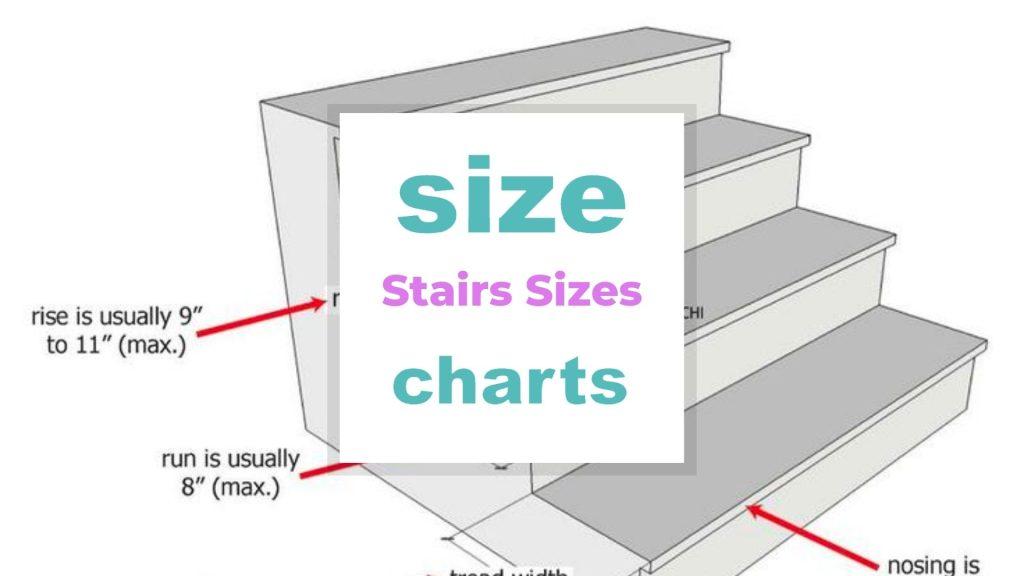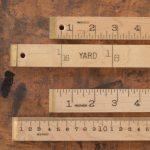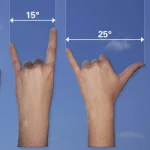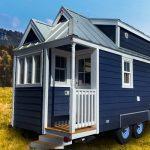Stairs Sizes: Standard Measurements
In this guide, we’ll walk you through the different types of stairs and help you choose the perfect option for your space (skip straight to the Stairs Sizes).
We’ll also go over the different dimensions, so you can be sure to find the perfect set of stairs for your needs. Let’s get started!

Jump right into the Frequently Asked Questions
Related: Bed sheet size and dimensions by type of bed (with size chart), Bed Size Chart – Measurements And Dimension for king, queen,… beds, Room Size for beds and mattresses, IKEA Mydal Bunk Bed Size Guide, IKEA Hemnes Daybed Dimensions
Stairs Sizes Table of Contents
- Standard Stairs size chart
- Standard Stair dimensions
- The standard stair width
- The standard stair height
- Frequently Asked Questions
Standard Stairs sizes chart
Related: Bed sheet size and dimensions by type of bed (with size chart), Bed Size Chart – Measurements And Dimension for king, queen,… beds
| Type | Stair Width | Stair Tread | Stair Riser Sizes | Stairs height | ||||
| in | cm | in | cm | in | cm | feet | meters | |
| Standard Stair | 36 | 91.4 | 11 | 28 | 7 | 18 | 10 ft | 3 |
| Egress Stair ( 50 people) | 36 | 91.4 | 11 | 28 | 4 | 10.6 | – | – |
| Egress Stair ( 200 people) | 44 | 111.7 | 11 | 28 | 7 | 18 | – | – |
| Egress Stair ( 2000 people) | 56 | 142.2 | 11 | 28 | 7 | 18 | – | – |
| Spiral Staircase | 36 | 91.4 | 11 | 28 | 6.7 | 17 | 9 ft | 2.75 |
| Switchback Stair | 36 | 91.4 | 11 | 28 | 7 | 18 | 10 ft | 3 |
Standard Stair dimensions
Related: Room Size for beds and mattresses, IKEA Mydal Bunk Bed Size Guide
Let’s take a look at some of the standard dimensions for stairs.
The width of a stair should be at least 36 inches (≈91 cm), but it can be wider if necessary. The depth of a stair should be at least 22 inches (56 cm), but it can be deeper if needed. The height of a step should be between 7 and 8 inches (18-20cm).
The tread should be at least 11 inches (28 cm) wide, and the riser should be between 4 and 5 inches high (10-13cm). There are some exceptions to these measurements, but these are the general guidelines that you’ll need to follow most of the time.
The standard stair width
Related: Queen Bed Size Chart and dimensions guide, King Bed Size Chart and dimensions guide
When it comes to stair width, there is a standard size that is followed by most builders. This is because there are certain safety guidelines that need to be adhered to in order to make sure that people can safely navigate up and down the stairs.
The standard width for a stair as we have already is around 36 inches, although there may be some variation depending on your location.
Keep in mind that this is just a guideline, and there may be circumstances where it’s necessary to have a wider or narrower stairway.
For example, if you have a lot of furniture that needs to be moved up and down, you may need to increase the width of your stairs.
The standard stair height
Related: Twin Bed Size Chart: Single bed dimensions guide , IKEA Hemnes Daybed Size and Measurements
So, what is the standard stair height? As a general rule, the standard stair height is 82 cm or 32 inches. This is the height from the top of the stair tread to the nosing.
However, there are some exceptions to this rule. For example, if you’re installing stairs in a commercial setting, you may need to adjust the height to comply with local building codes.
And if you’re installing stairs in a home that has low ceilings, you may need to reduce the height of the stairs to make them more user-friendly.
Learn more about Stairs Sizes (video)
Frequently Asked Questions
What influences the standard stair depth?
The standard stair depth is around 36 inches, but there are a lot of variables that can affect this measurement.
For example, the height of the stair and the width of the opening will both play a role in how deep your stairs need to be.
That’s why it’s always best to consult with a professional before you start tearing down walls or building your new staircase. They can take into account all of these factors and help you come up with a design that works well for your space.
What are the standard sizes of stairs?
When it comes to stair sizes, there are a few standard options to choose from. The most common width is 36 inches, but you can also get stairs that are 44 inches or 48 inches wide.
The most common height is 72 inches, but you can also get stairs that are 80 inches, 86 inches, or 92 inches high. And the most common depth is 12 inches, but you can also get stairs that are 16, 18, or 24 inches deep.
So, what’s the best option for you? It really depends on the space you have available and your personal preferences. Keep in mind that the narrower the stairs are, the more steps you’ll need to climb to get to the top.
What is the ideal width of stairs?
When it comes to stair width, there’s no one-size-fits-all answer. It depends on the space you have available, and also on the people who will be using the stairs.
But as a general rule of thumb, you want to make sure that the width of your stairs is at least as wide as the widest person who will be using them. This way, they’ll have enough space to walk up and down comfortably.
If you’re working with a tight space, you might need to go with a narrower staircase. But just keep in mind that this can be dangerous, especially if there are children or elderly people using the stairs.
So it’s always best to err on the side of caution and go with a wider staircase whenever possible.
How long do stairs need to be to go up 8 feet?
If you’re looking to install stairs that go up 8 feet, they’ll need to be at least 9 feet long. But it’s always best to consult with a professional to get the right measurements.
What is the 18 rule for a staircase?
The 18 rule is a guideline that helps make sure your staircase is safe and looks great. Basically, the 18 rule says that the rise plus run (r+R) of the stairs should equal 18 inches.
Additionally, the width of a staircase should be at least 18 inches wider than the widest part of the person using it. This is to ensure that people can use the stairs safely and without having to squeeze through.
It’s a safety measure that’s been in place for years, and it’s one that you should definitely keep in mind when designing your staircase.
Related rules include:
- There should be at least 18 inches of clearance between the handrail and the wall.
- The risers (height of each step) should be between 7 and 8 inches.
- The treads (width of each step) should be at least 10 inches.
If you’re remodeling your staircase or building one from scratch, make sure to follow these rules to avoid any accidents and create a beautiful focal point in your home.
Which stairs sizes take up the least space?
When it comes to space-saving stairs, the spiral variety is the way to go if you want to keep an eye on space.
As the name suggests, these stairs spiral around a central pole, which takes up a fraction of the space required by traditional stairs. They’re also perfect for tight spaces and can be installed in both homes and businesses.
If you’re looking for something a little more traditional, then the helical stairs might be a better fit. These are similar to spiral stairs, but the treads are attached to a helical or cylindrical support rail. This type of stair is perfect for small spaces and can be installed in either an interior or exterior setting.
What is the most efficient staircase?
Well, that depends on a few factors. First of all, how many people will be using the stairs regularly? And how much space do you have to work with?
If you’re looking for something that’s going to be used by a lot of people, you’ll want to go with a wider staircase. But if you’re short on space, a narrower option might be more appropriate.
In terms of height, most standard staircases are between 80 and 100 cm. But if you need something taller or shorter, there’s probably a model that will fit your needs.
Just keep in mind that the most efficient staircase is one that’s properly sized for your needs and your space. So take the time to measure before you make any decisions!
What is the most comfortable stair rise?
You’re probably wondering what the most comfortable stair rise is. Well, that depends on your personal preference. Some people prefer a smaller rise, while others find that a larger rise is more comfortable.
It really comes down to what feels the best for you. If you’re not sure, it might help to try out a few different staircases at a local store or take a walk up and down some stairs at your office or school.
Conclusion
Building or remodeling? Make sure you know the right stair size for your space! And hopefully, this guide has now given you the dimensions you need to make sure your stairs are just right.
In case of questions, please don’t hesitate to ask in the comments section.
Picture in this post is by Nick Fewings on Unsplash
Related to Stairs Sizes
- Barbie Doll Size : What are different sizes of Barbie ?
- Blanket sizes chart : blanket sizes and dimensions in inches & cm
- Tablecloth size chart – What are standard tablecloth sizes ?
- How Many Meters Are In A Yard?
- How Many Centimeters are 8 Inches?
- Knife Sizes and Different Types
- 4 Inches is How Many Centimeters?
- Light Bulb Base Sizes : What size light bulb base do I need?
- Tesalate Towel Size Guide
- Light bulb Size : What are the different and standard bulb sizes?
- Duvet Sizes: What is a Standard-Size Duvet?
- Single Car Garage Size and Dimensions
- How High Is A Story?
- How Much Does 1 Cup Of Rice Weigh?
- Cast Iron Skillet Sizes: What Size Do I Need?
- Dollar Bills Size Chart
- Pizza Sizes: Which One to Order?
- How To Measure A Foot Without A Ruler
- Wine Glass Size Chart
- Tiny Houses Size Charts
- How Many Inches Are In 20 Centimeters?
- How To Measure 1 Meter Without A Ruler?
- Nightstand Size and Dimensions for Bedroom
- Lamp Shade Size Guide – What size lampshade do I need?
























